Mark Anthony Neal's Blog, page 723
June 24, 2015
Connecting Inmates with Their Children through Books
 'A new program uses technology to fill an important role in the development of the children of those who are incarcerated. Organizers say the TeleStory program is the first of its kind in the country. At the main branch of the Brooklyn Public Library in New York, families of inmates bring their children to a special room filled with toys and books. Even more unique: the room is virtually connected to a prison on Rikers Island.'-- Marketplace
'A new program uses technology to fill an important role in the development of the children of those who are incarcerated. Organizers say the TeleStory program is the first of its kind in the country. At the main branch of the Brooklyn Public Library in New York, families of inmates bring their children to a special room filled with toys and books. Even more unique: the room is virtually connected to a prison on Rikers Island.'-- Marketplace
Published on June 24, 2015 20:38
"Prophetic Grief": A Sermon with Rev. Dr. Otis Moss, Jr. + Rev. Dr. Oits Moss III
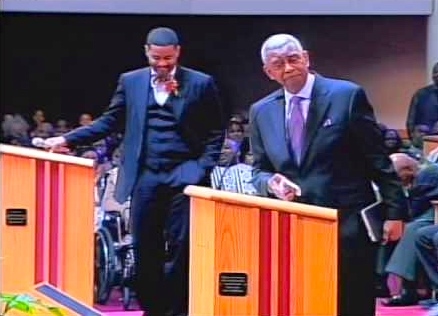 Rev. Dr. Otis Moss Jr. + Rev. Dr. Otis Moss III talk "Prophetic Grief" in the aftermath of the Charleston killings at Mother Emanuel AME Church.
Rev. Dr. Otis Moss Jr. + Rev. Dr. Otis Moss III talk "Prophetic Grief" in the aftermath of the Charleston killings at Mother Emanuel AME Church.
Published on June 24, 2015 20:16
The Breakbeat Poets: New American Poetry in the Age of Hip Hop
 "Hip-Hop is the largest youth culture in the history of the planet rock. It has produced generations of artists who have revolutionized their genre(s) by applying the aesthetic innovations of the culture. The BreakBeat Poets features 78 poets, born somewhere between 1961-1999, All-City and Coast-to-Coast, who are creating the next and now movement(s) in American letters. This is the first poetry anthology by and for the Hip-Hop generation. The Breakbeat Poets is edited by Kevin Coval, Quraysh Ali Lansana, and Nate Marshall." -- Haymarket Books
"Hip-Hop is the largest youth culture in the history of the planet rock. It has produced generations of artists who have revolutionized their genre(s) by applying the aesthetic innovations of the culture. The BreakBeat Poets features 78 poets, born somewhere between 1961-1999, All-City and Coast-to-Coast, who are creating the next and now movement(s) in American letters. This is the first poetry anthology by and for the Hip-Hop generation. The Breakbeat Poets is edited by Kevin Coval, Quraysh Ali Lansana, and Nate Marshall." -- Haymarket Books
Published on June 24, 2015 19:54
On the Confederate Flag and Reparations by Charles Bane, Jr
 On the Confederate Flag and Reparationsby Charles Bane, Jr. | special to NewBlackMan (in Exile)
On the Confederate Flag and Reparationsby Charles Bane, Jr. | special to NewBlackMan (in Exile)As the Confederate Flag starts its descent from capitol domes and merchandise sites, the time has never been more right for the work of Reconstruction, never undertaken, to begin.
The clearest signal of Reconstruction would be a demand of reparations taken up by the N.A.A.C.P. and its youngest and first female National Chairman, Roslyn Brock. The demand can be strengthened by the allied call of the National Organization For Women , The Anti- Defamation League and The National Congress Of American Indians. This must be accompanied by an end to mass incarceration that former Secretary of Labor Robert Reich has noted is racist, and ill- boding for our economy.
Also accompanying reparations must be an apology to the African American People by the government which enslaved them to create wealth from unwilling generations of workers. No President has ever issued such an apology.
There are thorny issues waiting to obscure the drive for success. Some may argue ( and the NAACP has played a past role in uncovering the following companies) that only those historic textile, railroad, tobacco, banking and insurance companies that directly profited from the slavery trade should be held accountable for their past actions: though it's obvious that the entire nation swelled and benefited because of slavery's existence.
Another argument quickly put forward by Caucasians at the mention of reparations is that , at this remove, it would be impossible to trace directly the descendants of slaves and that, furthermore, not all emigrants of color to America were enslaved. This is not only a false objection, but proves the very need for reparations to be of the widest band, because Black slavery and the terror that sustains it is not only of the past, but of the present day. Try to escape its legacy as you will; there is nowhere in America to go.
Figures vary widely, but there is agreement that $1.6 million dollars per household would allow Black America to leap ahead of disadvantages in wage inequity, housing and education and make them irrelevant in a single generation. The figure will be discussed and argued. But the numbers in the original ledger are not false and, in this, they are like the faith of Mother Emanuel.
Finally, an alliance with other minority organizations and cultures will strengthen the demand of a Black community that can make reparations a reality by following in Gandhi's footsteps and calling for a national strike. African Americans make up approximately 20% of federal, state and local employees, before even considering their influence on the private sector.
A flag is coming down. A cry is going up.
+++
Charles Bane, Jr. is a second generation civil rights activist and author of The Chapbook ( Curbside Splendor ) , Love Poems ( Aldrich Press) , and Three Seasons: Writing Donald Hall ( Collection of Houghton Library, Harvard University ). He created and contributes to The Meaning Of Poetry series for The Gutenberg Project, and is a current nominee as Poet Laureate of Florida.
Published on June 24, 2015 15:19
June 23, 2015
“Anyone Who Had a Heart”: Listening to Luther after Charleston by Mark Anthony Neal
 “Anyone Who Had a Heart”: Listening to Luther after Charlestonby Mark Anthony Neal | @NewBlackMan | NewBlackMan (in Exile)
“Anyone Who Had a Heart”: Listening to Luther after Charlestonby Mark Anthony Neal | @NewBlackMan | NewBlackMan (in Exile)Admittedly, the music of the late Luther Vandross seems an odd location to center Black emotionality in the aftermath of one of the most significant cases of anti-Black terrorism in the United States in recent memory. Vandross, who died a decade ago, is most remembered as the most gifted male pop vocalists of his generation, and in particular, for his ornate readings of the R&B ballad, elevating the form to works of art that remain peerless. Yet amidst the longings for love and the intimacy that frame so many of Vandross’ ballad performances, are deeply expressed fears of rebuke and betrayal, that resonate beyond the hetero-desires that popular understandings of Vandross’s music have been largely limited to.
“Anyone Who Had a Heart” was written and composed by the Hal David and Burt Bacharach, and recorded by Dionne Warwick in 1963. Released months after the bombing of the 16th Street Baptist Church, few, I imagine, would ever link that song--written by two White male songwriters and performed by a Black woman, who was married to one of the men--to that moment of terror. Indeed Warwick’s music in the period, generally speaking, was thought to be the very antithesis of music that we readily assign, now, as the soundtrack to the Civil Rights Movement.
Yet, two decades later, Vandross found value--in the melodies, the lyrics and the emotive possibilities, perhaps--in these seemingly forgotten pop ballads from the 1960s, as they served the needs of his performance of, as Jason King so brilliantly named it, a “sentimental” Black masculinity. Vandross’ version of “Anyone Who Had Heart” appears on his 1986 recording Give Me the Reason, and is one of four songs written and composed by Bacharach and David, and explicitly associated with Warwick that he records throughout his career, including his signature track “A House is Not a Home.”
Like Warwick’s music before him, Vandross’ channeling of Black sentimentality (and respectability), was generally thought to be out of sync with popular Black responses to Reagan-era anti-Black social policies and the explosion of crack-cocaine in Black urban centers, except to the extent that Vandross’ music served some Black desires to reconstitute heteronormative Black families (and by extension shamelessly deny and ignore Vandross’ attendant queerness, while mocking his “fat” corporeality--all of which Vandross also contributed to).
Then, as before, as now, anger and rage (or forgiveness) do not have a monopoly on Black emotionality in the midst of death, trauma and continued dispossession; if we are to allow that Blackness is diverse, our emotions are also so. And if this is the case, perhaps Vandross’ commitment to sentimentality has something to teach us.
In his essay “Still Life” (Small Axe 40, March 2013) the late political scientist and cultural critic Richard Iton addresses another moment of R&B sentimentality, produced three years before Vandross' solo debut Never Too Much. Chic’s “At Last I am Free” appears on their 1978 release C’est Chic, on which Vandross provides backing vocals. Though the album was largely driven by the dance hits “I Want Your Love” and “Le Freak” (which topped the pop charts), Iton found himself drawn to the obscure ballad “At Last I am Free,” in part, because the of the gap between how vocalist Alfa Anderson perceived the song’s sentimental lyrics about the end of a love affair, and the original intent of the song’s lyricist and Chic co-founder Nile Rodgers, who originally wrote the lyrics in an explicit political context when he was a member of the Black Panther Party in the 1960s.
Of the version of “At Last I am Free” that appears on C’est Chic, Iton writes, “it is hard not to hear in the title and the tone, anthemic chorus, and epic structure of Chic’s recording a reference to the familiar spiritual 'Free at Last' interpolated by Martin Luther King, Jr. in his ‘I Have a Dream Speech.’” Iton continues, “more broadly, one might argue that any black invocation of freedom, whatever the context, is at least subliminally entangled with the long histories of slavery, other practices within the colonial matrix, and their affects and effects.”
The shifting modalities of Black musical protest, as embodied by Chic and theorized here by Iton, provides a social context to examine what Vandross might have meant, or more apropos, what we might have heard or wanted to hear, or choose to hear now, when he sings “anyone who had a heart, would take me in her arms, and love me too.” To be sure, Vandross’ masking of same sex desire--”in her arms”--is a deliberate response to the possibility of rebuke, scorn and ultimately betrayal at the hands of those who ostensibly knew him best--his voice evoked and invoked at the apex of Black intimacy.
Yet there is the question as to why we chose to hear Vandross that way...why we needed to hear Vandross that way, given a tradition of masking our rage, anger, disappointment--and again that word betrayal--in the face of retribution and false empathies and sympathies, all coerced by the State. To hear Vandross as simply a sentimental, queer R&B singer was to displace the realities of that moment: crack, a fraying of the Black public, the assault of Black bodies--to recall those of another era like Michael Griffith, Yusef Hawkins, and even Tawana Brawley, because she represented the truth of what we know and what we have always known.
Almost thirty-years later Vandross again sings “Anyone Who Had a Heart..” and the betrayal is rendered emphatic; 9 dead Black bodies in the “sanctuary” of a historic Black church in a southern city. America has no heart; America don’t love us.
Published on June 23, 2015 14:43
Jazz Night in America: Kamasi Washington in Los Angeles
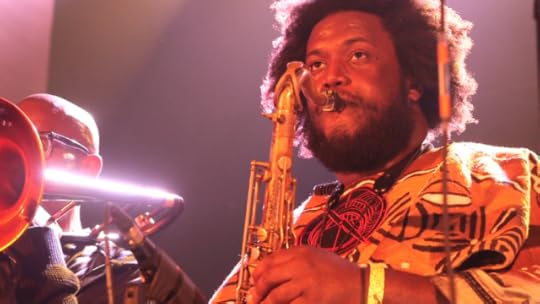 Jazz Night In America with Christian McBride visits saxophonist Kamasi Washington and documents the record release concert where Washington presented his new album The Epic complete with band, voices, strings and many special guests.
Jazz Night In America with Christian McBride visits saxophonist Kamasi Washington and documents the record release concert where Washington presented his new album The Epic complete with band, voices, strings and many special guests.
Published on June 23, 2015 12:12
Please Hold Your Applause Until the End: on Taking Down the Confederate Flag
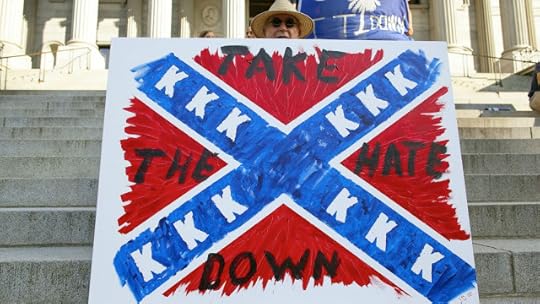 Please Hold Your Applause Until the End: on Taking Down the Confederate Flagby Lori Latrice Martin | @@blackbatonrouge | special to NewBlackMan (in Exile)
Please Hold Your Applause Until the End: on Taking Down the Confederate Flagby Lori Latrice Martin | @@blackbatonrouge | special to NewBlackMan (in Exile)Many people are applauding calls for the removal of the Confederate Flag from the State Capitol in South Carolina and Wal-Mart's decision not to carry items with the controversial emblem. To those people we say, please hold your applause until the end.
Symbols are powerful representations of shared meanings. Not only is the Confederate Flag a symbol, but calls for its removal from the public domain are also largely symbolic. These acts, while welcomed, do not address the myriad ways racism is manifested throughout American society, including throughout the various social institutions with which we come into contact everyday.
What the celebration surrounding the proposed removal of the historic relic reveals is a lack of understanding of what racism looks like in the post-civil rights era for many whites and even for some blacks. White racism looks like a 21-year old waving a Confederate Flag. It looks like the massacre of nine respectable black people in a house of worship.
It is far easier, and for some politically expedient, to rally behind efforts to memorialize seasoned black public servants than it is to rally behind urban youth thrown to the ground-or worse. The assault on young black bodies often end not with bipartisan and interracial coalitions and press conferences; rather, such assaults predictably end with discussions about "what's wrong with black youths" and how black youths should respond when encountering a person in a position of authority-even when that person is in the wrong.
The phrase Black Lives Matters refers not only to the dignity and humanity of blacks relative to whites and other groups, but it also refers to the dignity and humanity of blacks of every age, gender, ethnicity, and social class position.
We need a sincere and genuine commitment to social justice issues around matters of race that goes deeper than just scratching the surface of our torrid racial past. We need to understand that if and when the flag comes down in Charleston that children of color will continue to live in communities, sit in schools, and be driven down roads named for slaveholders, confederate generals, and segregationists.
We must come to the realization that people of color will still begin the journey that is life well behind the starting line because of historical and contemporary practices and policies, which privilege members of the dominant group and simultaneously disadvantage racial and ethnic minority groups. People of color will continue to feed the pipeline from schools-to-prisons and live in segregated communities not because of an inability to pay, but because of the desire to maintain social distance between various racial and racial minority groups and whites.
As is often the case, it takes a terrible tragedy-usually the loss of individuals people on the fringes or outskirts of the struggle for social justice deem worthy of respect-before people in positions of authority are compelled or willing to act.
Clearly, there is more work to do, so please hold your applause until the end and do not be frightened by the long periods of silence.
+++
Lori Latrice Martin is Professor of Sociology and African & African American Studies at Louisiana State University and the author of Black Asset Poverty and the Enduring Racial Divide and White Sports/Black Sports: Racial Disparities in Athletic Programs (Praeger Press).
Published on June 23, 2015 08:59
June 22, 2015
ReelBlack: Haile Gerima Talks Black Film and the LA Rebellion
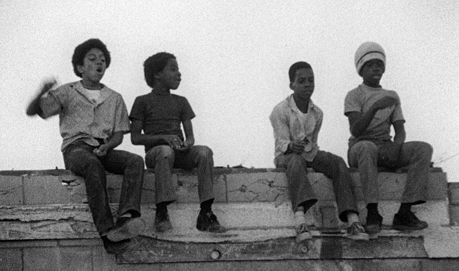 still from Charles Burnett's Killer of Sheep (1977)In this interview with ReelBlack, Filmmaker and Howard University professor Haile Gerima shares his definition of Black Film and his perspective of the LA Rebellion and Black Arts Movements.
still from Charles Burnett's Killer of Sheep (1977)In this interview with ReelBlack, Filmmaker and Howard University professor Haile Gerima shares his definition of Black Film and his perspective of the LA Rebellion and Black Arts Movements.
Published on June 22, 2015 14:28
On Point: Race & Violence in America with Anthea Butler + Mark Anthony Neal
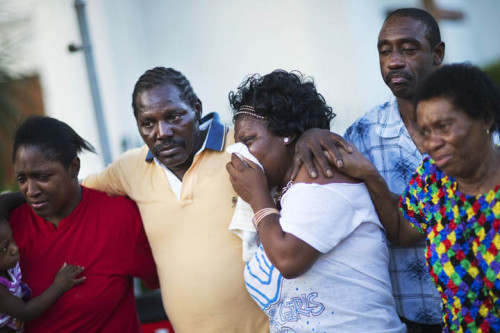 On Point with Tom Ashbrook discusses race and violence in the aftermath of the killings at Mother Emanual AME Church in Charleston. Ashbrook is joined by
Anthea Butler
, associate professor of religious studies at the University of Pennsylvania;
Mark Anthony Neal
, professor of African and African American studies at Duke University;
William McKenzie
, editorial director for the George W. Bush Institute at the George W. Bush Presidential Center.
On Point with Tom Ashbrook discusses race and violence in the aftermath of the killings at Mother Emanual AME Church in Charleston. Ashbrook is joined by
Anthea Butler
, associate professor of religious studies at the University of Pennsylvania;
Mark Anthony Neal
, professor of African and African American studies at Duke University;
William McKenzie
, editorial director for the George W. Bush Institute at the George W. Bush Presidential Center.
Published on June 22, 2015 13:34
June 21, 2015
'Project Fatherhood': In A Struggling Neighborhood, Dads Are Helping Dads
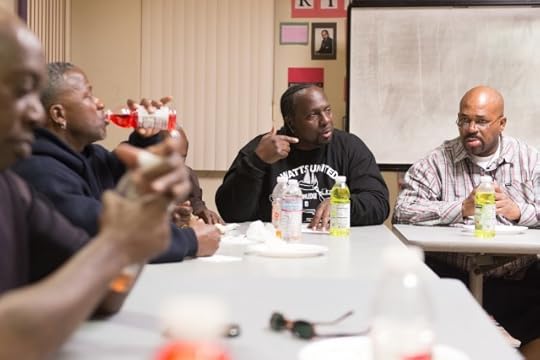 Brandon Choe / Daily Bruin A dedicated group of Black fathers in Los Angeles is working to help neighborhood dads do better by their children and their community. -- NPR's Code Switch
Brandon Choe / Daily Bruin A dedicated group of Black fathers in Los Angeles is working to help neighborhood dads do better by their children and their community. -- NPR's Code Switch
Published on June 21, 2015 07:23
Mark Anthony Neal's Blog
- Mark Anthony Neal's profile
- 30 followers
Mark Anthony Neal isn't a Goodreads Author
(yet),
but they
do have a blog,
so here are some recent posts imported from
their feed.



